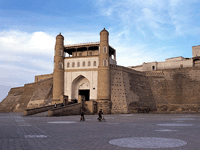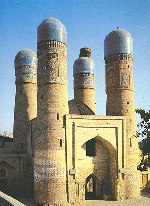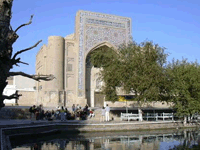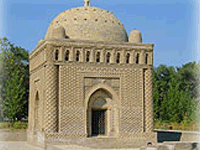 | BUKHARA Bukhara
is mentioned in the Holy Avesta book as one of the most ancient Uzbek towns built
on the sacred hill of springtime offerings put by Zoroastrians. The name 'Bukhara'
derives from the Sanskrit word 'vikhara' denoting 'temple, cloister'. In the course
of centuries it had different names Numizhkat, Madinat-us-Suphia, Madinat-ut-Tudjar,
Fakira, etc.
 FORTRESS
ARK FORTRESS
ARK
This royal town-within a twin is the most ancient edifice in Bukhara,
dating back to the 5th century AD. Bits of its original walls could be kept thousand
years. Drum being walls are less than 300 years old. The interior needs restoration
and some parts collapse as time goes by.

Chor-Minor
(1807)
This picturesque small building built in 1807 together with medressa
of Caliph Niyazkul, a rich dealer from Turkmenistan, reminds more an Indian style
rather than Bukharian. Chor Minor - Persian for "Four Minarets". However,
more likely, there are four imitations of minarets only. One of the "minarets"
fell in 1995. Storks have nested on minarets till recently.
 Lyabi-Hauz
Ensemble (+17th century AD) Lyabi-Hauz
Ensemble (+17th century AD)
Labi-Hauz is a square built around reservoirs
in 1620. Labi-Hauz means "around the pool" in Tajik. It is the most
peaceful and fascinating spot in the city where aged vendors get together, and
elders are bending over chessboard or are drinking tea.
Ismoil
Somoniy Mausoleum (10th century AD)
Ismoil Somoniy Mausoleum. The most
ancient architectural monument of the city is situated in the park of Ismoil Somoniy,
the founder of Samanids Dynasty. The mausoleum was built 905 AD and is one of
the most elegant edifices in Central Asia. Ismoil Somoniy's father and grandson
were buried here in the mausoleum as well. The mausoleum is delicately built of
terracotta bricks (Muslim bricks). Although it has no bright paints, no brilliant
ceramic tiks, the edifice does not concede to other ancient architectural monuments,
that are stuffed with glaze and other bright ornament. The bricks create shadow
effects substituting unnecessary paints. The walls are almost 2 meters thick helping
it to survive 11 centuries without any restoration.
Other historical
and architectural monuments of Bukhara
Bolo-Hauz ensemble (beginning of
the 18th-20th cc.)
Chashma-i-Ayub Mazar (1380 or 1384/85)
Abdullah-Khan
medressa (1596/98)
Modariy-Khan medressa (1556/57)
Baland Mosque (beginning
of the 16th c.)
Gaukushon Ensemble (Mosque, Minaret, Medressa 16th c.)
Hoja
Zaynuddin Mosque (1555)
Poi-Kalan Ensemble (12th-14th cc.)
Kukeldash Medressa
(1568/69)
Nodir-Divan-Begi Khanaka (1620)
Abdulaziz-Khan medressa (1652)
Bolo-Hauz
Mosque (1712)
Saifuddin Bukharzi Mausoleum (16th c.)
Buyan Kulikhan Mausoleum
(14th c.)
Namozgokh Mosque (16th c.)
Faizabad Khanaka (1598/99)
Bukhara
Emir's Palace Sitorai-Mokhi-Hosa (end of the 19th c. - the beginning of the 20th
c.)
|  |